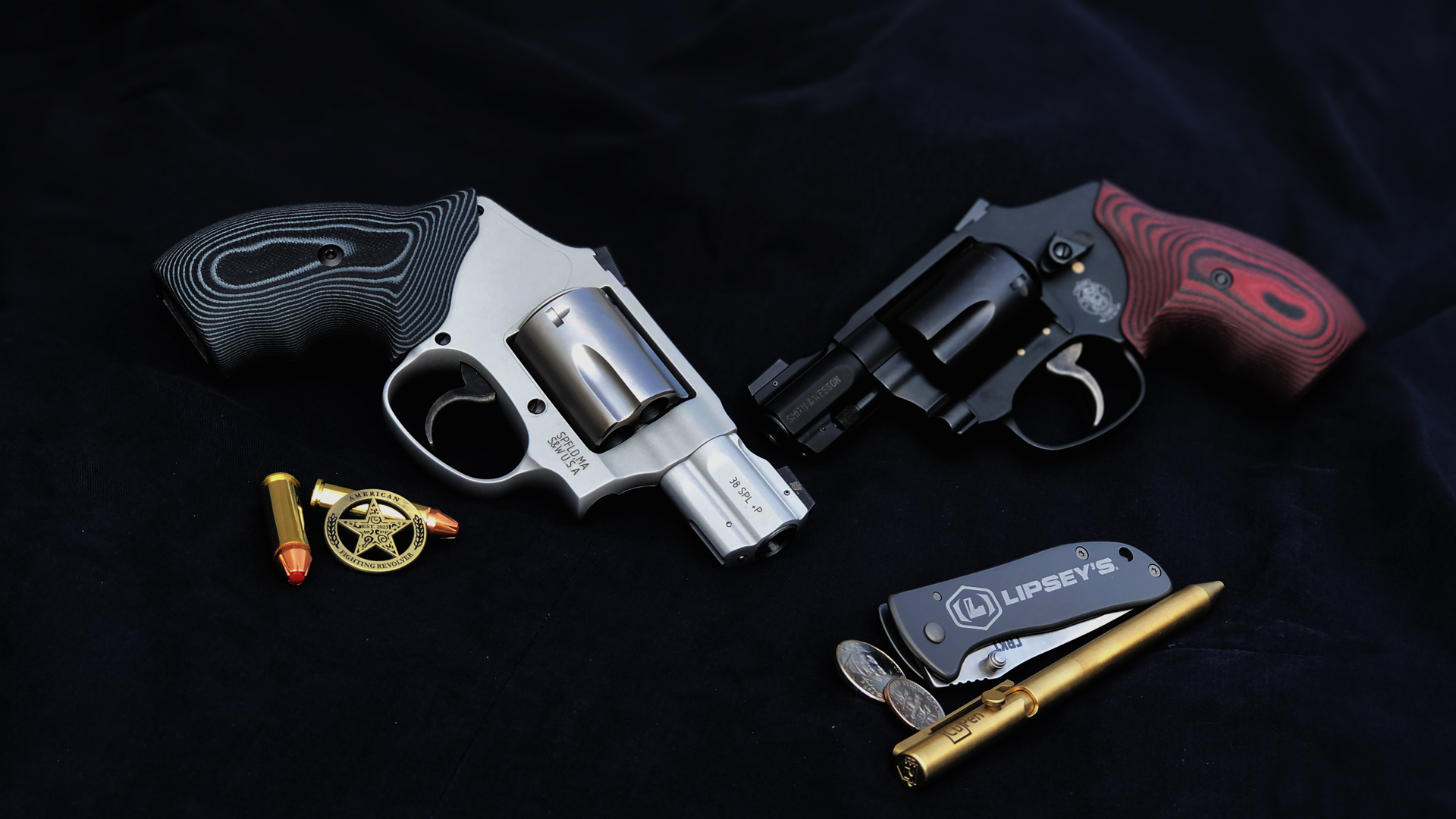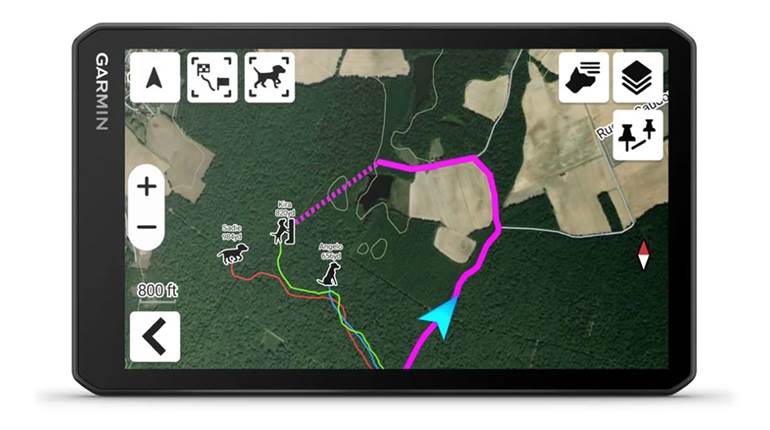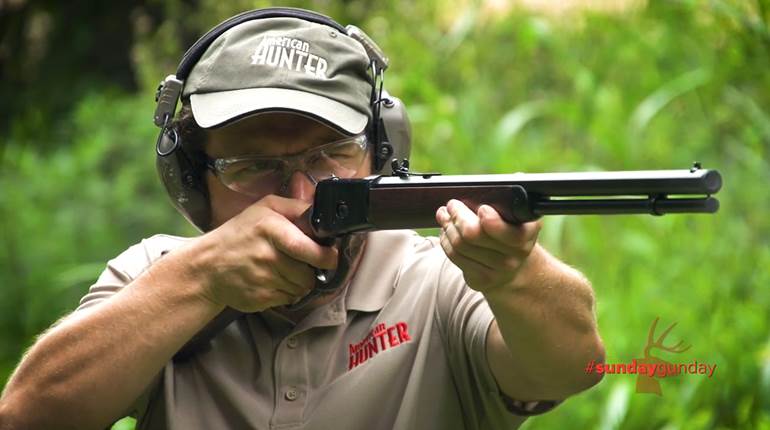
Chances are that at least some of the firearms in the case or on the wall at your local gun shop came through Lipsey’s, one of the industry's leading firearm distributors. Most shooters probably know the Baton Rouge, La., business, at least indirectly, by the company's popular exclusives and special editions. The Vicker’s Tactical Glock series, for instance, and the Ruger Flattop .44 Specials are but two of the numerous examples from Lipsey's. For 2024, Lipsey’s partnered with Smith & Wesson for an exclusive, fully featured new J-frame revolver, in both .38 Special and .32 H&R Magnum.
The Lipsey’s Ultimate Carry (UC) J-frame boasts exclusive sights, grips and a host of first-time features in both stainless and a blackened finish on the Aluminum Airweight frame in the concealed hammer models 642/442 in .38 Spl +P (five-shot) and 632/432 in .32 H&R Magnum (six-shot). It has been a long time since S&W has offered a snub-nose .32 H&R, and the chambering of the Ultimate Carry is enough to grab attention. With an MSRP of $759, these models hit the mid price-point between the basic 642 and the ultra-lightweight Scandium models such as the magnum 340 PD.
Backstory
The project started simply, with a notion to put a great set of sights on the bread-and-butter 642 model .38-cal. snubby. The 642 is a staple defensive/backup gun and has been in the market relatively unchanged for a generation or more. S&W’s Pistol Product Manager Andrew Gore saw the potential to expand, from adding some type of upgraded sights to turning the engineers loose to fully update the popular revolver.
Jason Cloessner, Lipsey's senior vice president of product development, is both an avid shooter and wheelgun kind of guy, and as the project expanded, he tapped into his network of shootists and S&W fans to ask for the full dream sheet of possibilities. Andrew met that list and then upped it a notch or two further, adding internal upgrades. As the project was nearing settled specifications and cost data, the final stroke of music to snub lovers’ ears was S&W agreeing to add .32 H&R Magnum as a chambering.
Ultimate Carry Features
We can cover the extensive list of features in three tranches. The first are the most important. Over the years, many different authorities have summarized upgrade/modification recommendations to defensive handguns as something close to “sights you can easily see, a usable trigger and a grip that fits the shooter.” The Ultimate Carry Smiths deliver in each of these. The Ultimate Carry J-frame has the best sights, trigger and stocks ever offered on the Airweight frame.

The Ultimate Carry sights are a combination of a dovetailed, snag-free U-notch rear and a pinned in XS Sights front housing a tritium lamp surrounded by a bright neon-green ring. The big, green dot is bold in every lighting condition and is "un-missable," even if the shooter has their vision focused hard on the target. The U-notch rear has a wide opening surrounded by a finely serrated face. The rear sight is drift-adjustable for windage and has a set screw to lock the unit in place. Once shooters get these sights to the range and can experience them, I suspect that very few will change them, but the pinned-in front sight will allow easy customization.
The trigger on the Ultimate Carry revolvers is double-action-only since the "hammerless" frame on the 642/632 conceals an internal hammer that prevents thumb-cocking as on the shrouded hammer Bodyguard (638/49) series guns. I’ve fired more than a dozen of the Ultimate Carry snubs, and triggers on them have been uniformly good. The pull weight on my test revolvers range from 9.5 to 10.5 lbs. Revolvers seem to have a degree of variation or "character" to individual guns because of how the parts come together and wear-in. I’ve handled some of the Ultimate Carry revolvers with trigger pulls that are on the cusp of custom action jobs and others that are simply good for a production Airweight. I’ve not yet handled one that was merely OK.
The stocks on the Lipsey’s exclusive are a unique boot style by VZ Grips, extending to flush with the bottom of the frame. The G10 stocks fully cover the backstrap and extend in "high horn" style to the top of the grip frame. These are the best J-frame grips I have experienced, masterfully tackling the inherent competing requirements that manifest when shooting a snub. The G10 gives just enough texture to anchor the handgun in the grasp while remaining comfortable for concealed carry by allowing clothing to slide past, unlike many rubbery stocks. The size fits many hands well. The gun positions the shooter in a favorable firing grasp to stroke the double-action trigger. However, the VZs remain slim and small, enough to work well in pocket- or ankle-carry configuration. Finally, the enclosed backstrap and overall shape handled stout +P loads in the 16-oz. Airweights as well as one can ask, spreading the impact along the entire grip and giving the shooter a firm surface to hang onto.
The second tranche of new features include the "no lock" frame, chamfered charge holes and the two-piece barrel. This is one of the few instances where an Airweight J-frame has been offered without the much-disliked safety lock. I’ve yet to meet an actual person who uses the little keys to disable their revolver for safety, but I know plenty of shooters who have strong feelings of distrust, or worse, about having a disabling mechanism built into their defensive handgun. To accommodate the pinned XS sights, S&W had to go to a two-piece barrel as on its Scandium M&P series snubs, and when making the change to the frame, the company took up Lipsey’s request to delete the lock. The two-piece barrel allows Smith to control barrel/cylinder gap more precisely, which should help maximize velocity out of the short barrel, and it brings along a shroud to enclose and protect the ejector rod.

Chamfered charge holes is often a custom touch where shooters have a gunsmith slightly bevel the edges of each charge hole in the cylinder to aid reloading. The chamfering on the Ultimate Carry guns is light but effective. When single loading rounds casually at the range, it is convenient. For those carrying the new J-frame as a defensive or backup gun where the user might be recharging the limited capacity in the small cylinder under duress, the feature makes a large difference.
Finally, the new Smiths have upgraded the aluminum pins inside the revolver to tougher titanium pins. Few people will shoot a J-frame to destruction, but it was possible and now enters the realm of the highly unlikely. Sharp-eyed readers will notice that there are some contrasting two-tone effects on the stainless models’ screws, cylinder release, and ejector rods, this was done to further distinguish the exclusive Lipsey’s models from the stock 642.
Shooting The Ultimate Carry
I was invited to an event at Lipsey’s where a small group of writers put a hard day of shooting on the .38s and .32s. We were able to fire a wide variety of loads in both calibers and everywhere from typical defensive range out to 50 yards. Lipsey’s had brought Bryan Eastridge and Darryl Bolke of American Fighting Revolver in to provide instruction and lead the range events, and they were able to show many of the new revolver’s features in practical context. You often hear snubs talked about as "arms’-length" guns or other dismissive descriptions, but this group included longtime wheelgunners who could take the enhanced features on the Ultimate Carry guns and make the snubs do some very "un-snublike" things. I recall the whole line of shooters reliably hitting reduced silhouette steel out to 30 yards and most kept the steel ringing even farther out.
Among this group were very seasoned writers who are deep on the small revolver and have tested or carried all of the major brand offerings and custom variations. The high praise being heaped on the new Lipsey’s/S&W models was not idle bluster. The features come together quite well.
I spent a couple of months back home with samples of each Ultimate Carry model and put several hundred more rounds through them. The accompanying table shows a representative five-shot group with velocities for varied loads. Small revolvers are often benched at 7 yards; I shot for groups at 20 yards, out of curiosity’s sake. Shooting 16-oz. double-action-only revolvers off of the rest is a great challenge, so where I saw the front sight swerve out of line and called a bad shot, I removed the corresponding flier and reshot a clean break to make the five-shot groups. With most of the groups, this wasn’t required. As you can see, the little Smiths shoot out of proportion to their size.
I enjoyed shooting the little wheelguns against some challenging steel targets. I have a 3"x6" piece of steel I call the "truth teller." To hit that small piece at any distance, you have to both know exactly where to hold for a given load and be able to break the shot cleanly. With either .32 or .38, I was encouraged to be able to consistently get all but one out of a cylinder to smack the steel and send it swinging on its hook from 20 yards out. With the 432 Ultimate Carry, I was even able to get all six onto the steel on one attempt at that very non-pocket-gun-typical distance. The little .32 shoots well enough that you could almost make an argument for it as a featherweight trail gun.

On challenging drills with fixed time limits, like the Double & 1 and Prep Time, the Ultimate Carry snubbys were far closer to my usual performance with micro-size 9 mm semi-automatic pistols than I might have expected. On drills focusing purely on speed, the snubs couldn’t run with the semi-autos, but in most cases, the performance was still satisfactory.
I had initially held some reservations about the rounded top of the XS front sight and the large U-notch rear; I was concerned that I wouldn’t get the level of precision I expect at extended distance. I was wrong. The sights were fantastic inside of 10 yards. That big, green dot seeming to jump out at the eye and nestle confidently in the U-shape trough. Up close, that big, neon front seemed almost like a bright electronic green-dot optic that was missing its housing frame.
At distance on challenging shots, perfect alignment took a little more visual effort than typical tight square notch/front arrangements, but I was consistently able to get hits that were punching way above their weight class. I do suspect that the nature of the round-dot/U-notch arrangement will see some shooters having to experiment to ensure that point of impact with a chosen load is as they wish.
Related to this, I have seen some inconsistency in vertical point of impact from gun to gun in the early production models. At defensive distances, it may be unnoticeable, but the factory intended for the models to hit point of aim at 15 yards with the most common JHP loads.
It is worth saying again that the grips, sights and trigger on the Ultimate Carry models come together in a way that is more than the sum of the parts. A snubnose revolver is never going to be "easy" to shoot compared to a full-size handgun, but these were far and away easier to shoot than a stock 642. I was repeatedly getting hits with these Ultimate Carry snubs that I wouldn’t believe if I read them from someone I didn’t know or wasn’t there on the range when it happened.
The .32 models could actually be described as enjoyable to shoot, a word not often associated with an Airweight .38. Space may require a follow-up article, but the .32 H&R Magnum may be the perfect J-frame chambering for many users. A shooter gets a sixth round, a tolerable level of recoil yielding better control and more practice, and gel penetration meeting or exceeding some loads’ short-barrel .38 results.

The market is full of great holster choices for the new Lipsey’s exclusives. Whether carrying on or, inside the belt, in the pocket or on the ankle, there are plenty of options. During the media event, I used a Simply Rugged pancake-style belt holster. I later have carried either the .32 or .38s in an old Renegade ankle holster or inside the waistband in a beautifully made new Garrity Gunleather model I bought to accompany the new Smiths. I had forgotten just how convenient a J-frame can be to carry, nestling in comfortably at the belt line and almost forgettable. The shape, contour and light weight of the 642/632 just make it work well inside or on the belt line, in larger pockets and on the ankle. They are among the easiest of handguns to truly live with, and this alone explains some of their enduring popularity.
The Ultimate Carry Js seemed to have received outsize attention at both the SHOT Show and the NRA Annual Meetings & Exhibits convention. I’ve noticed an unusual amount of online discussion and buzz indicating that the new exclusives may just be the generational update the market was ready for. Asking Lipsey’s how they perceived the reaction, Jason Cloessner said, “The most rewarding part of this whole project is to see the overwhelming positive response to the Ultimate Carry by hardcore shooters who are very particular about what they carry. We knew the market wanted a small-frame revolver with great sights, a good trigger and comfortable stocks, but our expectations have been greatly surpassed.”
Smith & Wesson has a long history of iconic models with grandiose names that may seem somewhat presumptuous at launch, only to be validated with their reception by shooters. The K-38 Target Masterpiece truly was, and the Chief’s Special defined the initial J-frame revolver embraced by police leadership and plainclothes officers. The Ultimate Carry J-frame is a bold title that may prove to be fitting.
This story has been updated to correct a statement about the availability of Airweight J-frames without the internal safety lock.




































